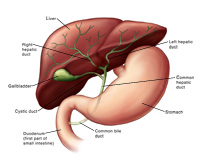Anatomy of the biliary system
The biliary system consists of the organs and ducts (bile ducts, gallbladder, and associated structures) that are involved in the production and transportation of bile.
The transportation of bile follows this sequence:
When the liver cells secrete bile, it is collected by a system of ducts that flow from the liver through the right and left hepatic ducts.
These ducts ultimately drain into the common hepatic duct.
The common hepatic duct then joins with the cystic duct from the gallbladder to form the common bile duct. This runs from the liver to the duodenum (the first section of the small intestine).
However, not all bile runs directly into the duodenum. About 50% of the bile produced by the liver is first stored in the gallbladder. This is a pear-shaped organ located directly below the liver.
Then, when food is eaten, the gallbladder contracts and releases stored bile into the duodenum to help break down the fats.
Functions of the biliary system
The biliary system's main function includes the following:
■ To drain waste products from the liver into the duodenum
■ To help in digestion with the controlled release of bile
Bile is the greenish-yellow fluid (consisting of waste products, cholesterol, and bile salts) that is secreted by the liver cells to perform 2 primary functions:
● To carry away waste
● To break down fats during digestion
Bile salt is the actual component that helps break down and absorb fats. Bile, which is excreted from the body in the form of feces, is what gives feces its dark brown color.
Medically Reviewed by Minesh Khatri, MD on April 22, 2021
How Can I Prevent Gallstones?
Being overweight or having diabetes puts you at a higher risk of getting gallstones. But in general, a sensible diet is the best way to prevent them. Avoid crash diets or a very low intake of calories (less than 800 calories daily). Seek out good sources of fiber -- raw fruits and vegetables, cooked dried beans and peas, whole-grain cereals and bran, for example -- and avoid eating too much fat. A high-fiber, low-fat diet helps keep bile cholesterol in liquid form. However, don't cut out fats abruptly or eliminate them altogether, as too little fat can also result in gallstone formation.
Researchers have found that drinking coffee reduces the risk of gallstones.
Recent studies have shown that moderate consumption of olive oil (about 2 tablespoons a day) may actually lower your chances of developing gallstones. An ingredient in olive oil evidently helps reduce cholesterol levels in the blood and gallbladder. Researchers have found that the incidence of gallstones is relatively low among people who live in areas where olive oil consumption is high.


No comments:
Post a Comment